Thinking ahead: A backgrounder on Transport 2040 and our 2010 10-year plan
Thinking ahead: A backgrounder on Transport 2040 and our 2010 10-year plan
TransLink CEO Tom Prendergast gave a speech at the Vancouver Board of Trade this morning, discussing our long-term strategies and the challenges we’re facing as our transportation network grows.
So, I thought I’d take this opportunity to start highlighting the same topics, since we’re actually going to be talking about this a lot over the coming year.
It really might sound kind of sleep-inducing, but please don’t let your eyes glaze over! We’re planning the future of transportation in our region here, and we want you to be informed about what we’re doing and where we’re coming from.
First things first: 30-year plans vs. 10-year plans
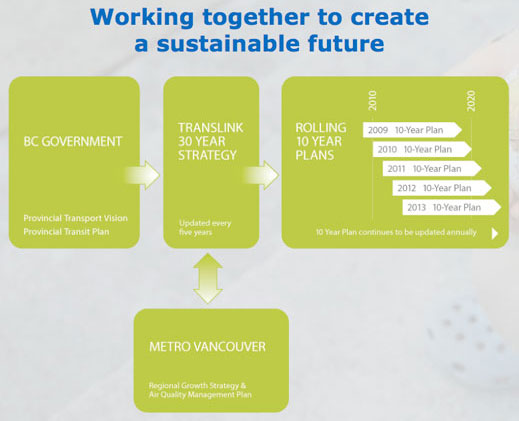
We have two plans that guide our decision-making at TransLink – plans for the next 30 years and the rolling 10-year plans that will make the long range vision into reality.
The 30-year plan is a long-range document, which sets the direction for our short-term planning. There’s no specific projects in it, just strategies and goals. It is updated every five years.
The 10-year rolling plan is updated annually and contains the concrete projects and steps that we will take to accomplish the goals in the 30-year plan. We reconsider and revise this 10-year plan every year nd project out a further nine years to keep us on course to hit our 30-year goals. That’s why we call it a “rolling” 10-year plan.
Right now, the 2009 10-year plan has already been determined, but we’ll be consulting and talking about the 2010 10-year plan in the near future.
Transport 2040 is our 30-year plan, and it was developed this year after consultation in fall 2007. The last long-range plan we had was Transport 2021, which was adopted by Metro Vancouver in 1996. Metro Vancouver is also currently updating its strategic growth plan right now, so it’s timely that we’re both thinking about the future of our region.
If you’d like to read the Transport 2040 plan in detail, please feel free to visit our public consultation page and download the final Transport 2040 document. You can also find the final 2009 10-Year plan up there already, if you’re curious.
Six goals for Transport 2040, a.k.a. our 30-year plan
We have six core goals for transportation in 2040, which are:
- Greenhouse gas emissions from transportation are aggressively reduced, in support of federal, provincial and regional targets
- Most trips are by transit, walking and cycling
- The majority of jobs and housing in the region are located along the Frequent Transit Network
- Traveling in the region is safe, secure, and accessible for everyone
- Economic growth and efficient goods movement are facilitated through effective management of the transportation network
- Funding for TransLink is stable, sufficient, appropriate and influences transportation choices
(What’s the Frequent Transit Network? Essentially, we’re looking to build a network of routes where transit service is provided every 15 minutes or better from morning to evening, every day of the week, on corridors with densities and land uses that promote maximum ridership. That network of routes is the Frequent Transit Network, and it’s already in place in some parts of our region.)
The goals didn’t come from thin air. They stem from a series of consultations we did in fall 2007. TransLink went out and consulted with key stakeholder groups, local government representatives, and subject area experts to define the challenges, identify goals, and develop strategies for the next 30 years.
To ensure a diversity of views, we also commissioned perspective papers from eight stakeholder groups, met regularly with a Stakeholder Roundtable, and held consultation forums with participation from approximately 200 stakeholder groups, organizations and members of the public. (The groups included the Gateway Council, Better Environmentally Sound Transportation, Vancouver Board of Trade, Fraser Basin Council, Smart Growth BC, SPARC BC, and the BC Chamber of Commerce. You can read their contributions at the Transport 2040 page.)
As well, these goals also fit within the Provincial Transport Vision and Provincial Transport Plan.
Four strategies to achieve our Transport 2040 goals
How we achieve our goals is really as important as the goals themselves. We developed four strategies to take us to our Transport 2040 goals:
- Strategy 1: Make early investments that encourage development of communities designed for transit, cycling, and walking
- Strategy 2: Optimize the use of the region’s transportation assets and keep them in good repair
- Strategy 3: Build and operate a safe, secure, and accessible transportation system
- Strategy 4: Diversify revenue sources and pursue new and innovative ways to fund transportation
The challenges ahead!
The challenges. Oh, the challenges for transportation in our region. There’s actually five big ones, and we will be talking a lot about strategies to manage each challenge as we go out and consult with you on the 2010 10-Year Plan.
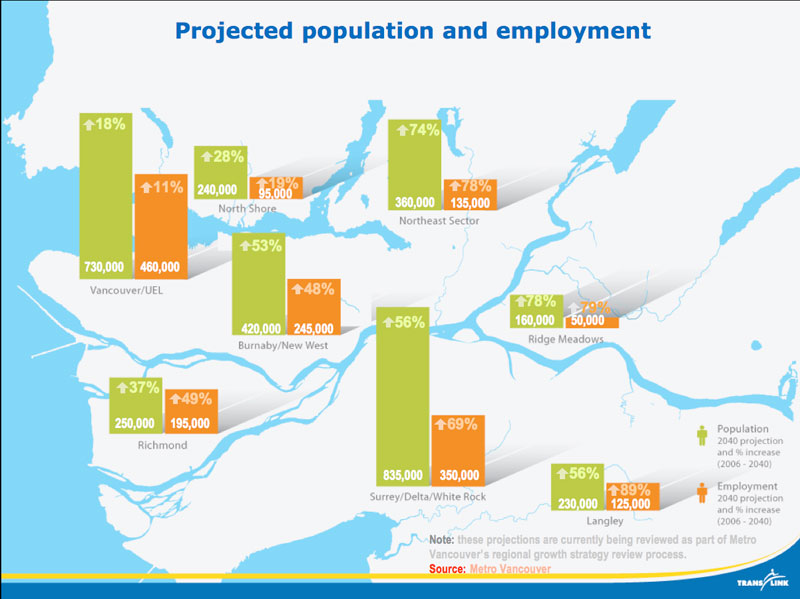
Population and employment growth
Population and employment growth are only going up in our region, and it’s centred in the south and east areas where use of transit, cycling, and walking is relatively low. (In municipalities east of the Pitt River and south of the Fraser River, 90 per cent of trips are taken as a driver or passenger in a private vehicle.)
As well, many of the region’s new jobs are also located in business parks, which is a significant challenge from a transportation perspective. Business parks aren’t generally within walking distance of places where people live, shop, or eat, and are difficult and time consuming to get to on public transit. Business parks are also growing four times faster than regional city centres, also known as developments around high-quality rapid transit lines.
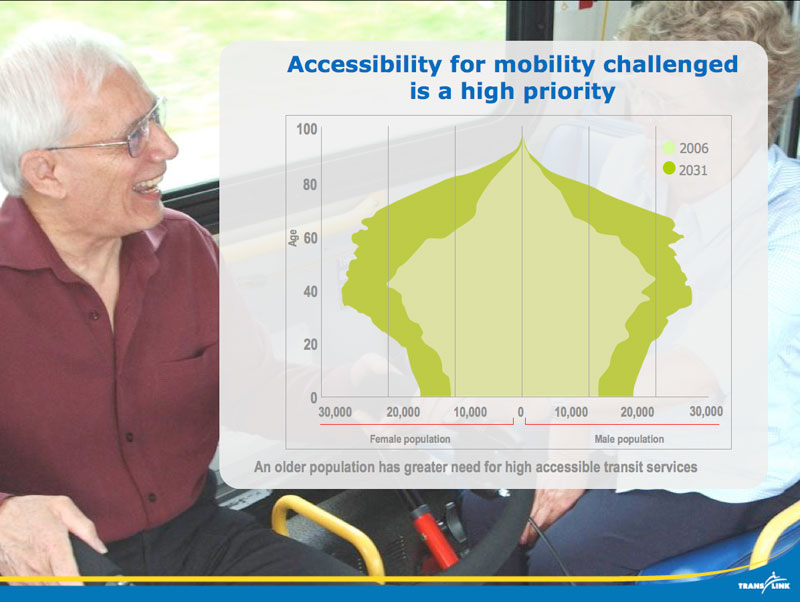
An aging population
Estimates indicate that an extra 1 million people will live in the Metro Vancouver region by 2040. The median age of residents will be 46 years, and about one-quarter of residents will be 65 or older.
So, the system we build has to accommodate the needs of an older population as well as accomplishing our 30-year goals. It means we have to plan wisely to make sure an older population will be able to take transit, cycle, or walk to the destinations they can get to.
And if housing, jobs, and services are developed in locations that support public transit development, more trips can be made on foot, by bike, or on transit. Complete communities are more easily linked to other areas, reducing dependence on private vehicles.
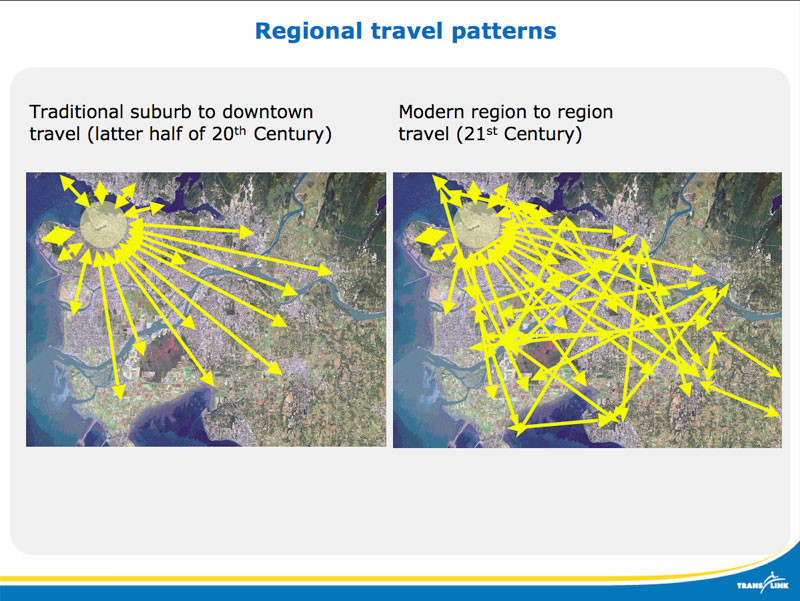
Regional travel patterns
Historically, travel was to and from Vancouver, and now travel is from everywhere to everywhere. So the challenge has moved from getting everybody to a central location to getting people to their destinations all over the map!
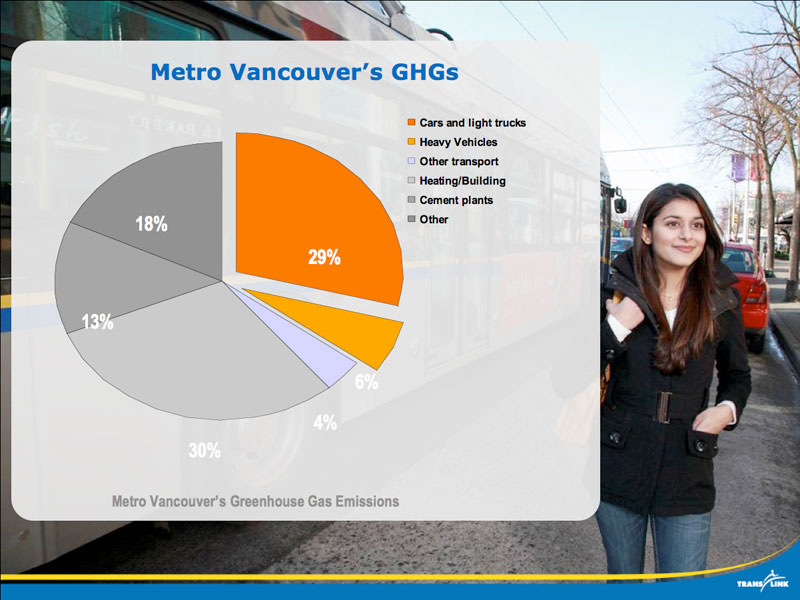
Greenhouse gas challenges
We want to aggressively cut greenhouse gases, for our own good as well as to reach federal, provincial, and regional targets. Those targets are significant, though: all three levels of government want to drop emissions by roughly 33 per cent by 2020 from 2007 levels. In Metro Vancouver, 35 per cent of greenhouse gases come from cars, light trucks, and heavy vehicles, meaning we’re facing a big challenge in helping people make smart transportation choices. That could come from driving less, buying cars with better emissions ratings, or lowering carbon transportation fuels.
As well, with climate change happening, TransLink also has to plan for changes to our local environment and region, such as weather pattern changes or increased risk of flooding.
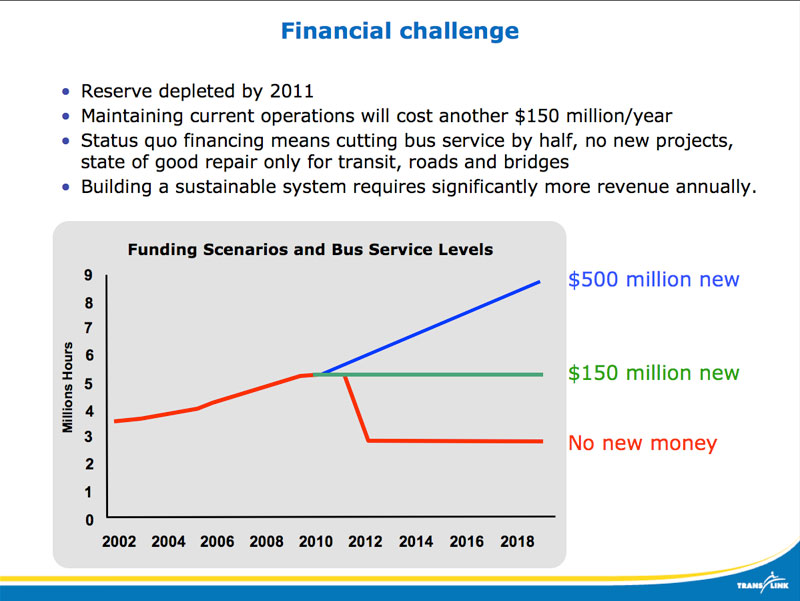
Financial challenges
Wouldn’t it be easy if we had all the money we needed to implement everything the public wants us to do in 30 years? Unfortunately, that’s just not the situation we find ourselves in.
The hard fact is that TransLink is going to deplete our $450 million reserve by 2011. After that, we need another $150 million of new money to maintain current operations. Without new revenue, staying afloat will mean cutting bus service by half, no new projects, and maintaining only transit, roads, and bridges in a state of good repair. If we want to expand to accomplish the 30-year goals that the public wants, we need an extra $500 million on top of that $150 million.
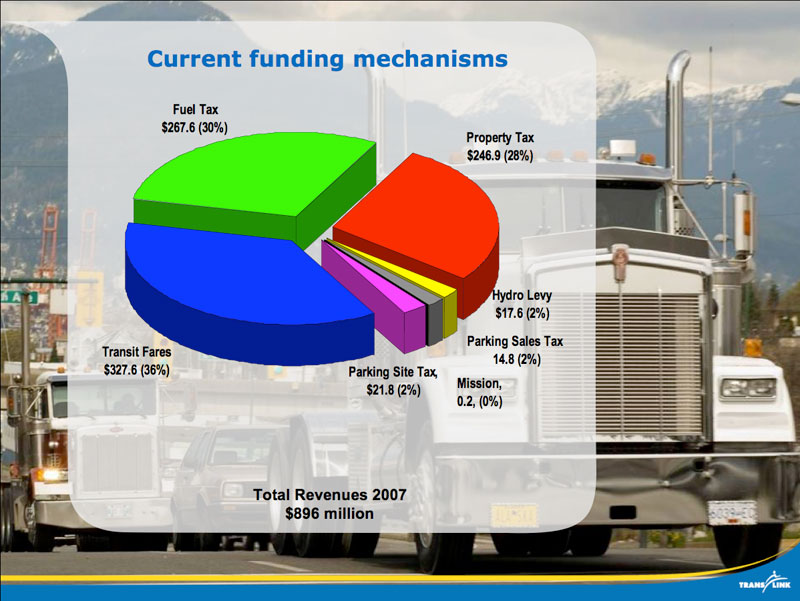
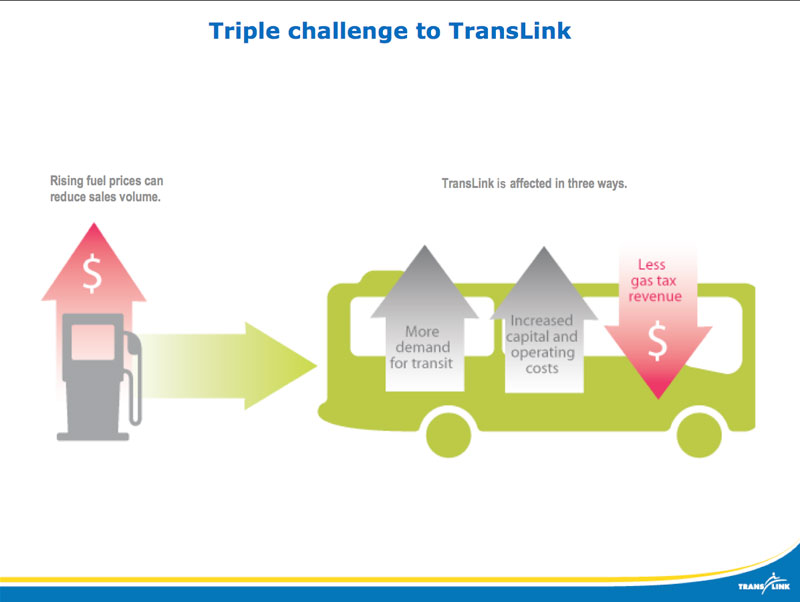
Rising gas prices have not helped us in the slightest—it has in fact, really hurt us in three ways. Expensive gas leads to increased transit demand, plus increased capital and operating costs to handle this higher demand—and the loss of more drivers on the streets means we get less gas tax revenue to fund our system. The fuel tax makes up 30 per cent of our revenue, and losing part of that money means we need new money from somewhere else.
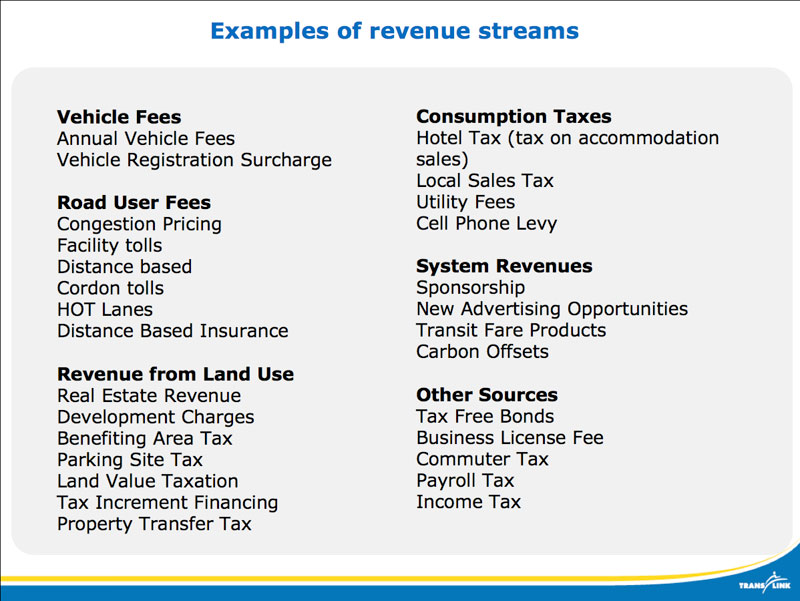
There’s been a lot of talk about the vehicle levy, but the truth is that it’s just one of many options we have to increase our revenue. The picture above shows the huge list we’re looking at. Over the next year, we’re going to explore all of them, and we’re going to consult with you to find out which revenue streams would work best.
We will also be trying very hard to draw on a range of revenue sources rather than putting all our eggs in one basket. A diversity of sources will help our funding stay sustainable and consistent in the years to come. We will also look for more support for capital projects from senior government sources, who have made great contributions in the past for projects like the Canada Line and the Evergreen Line.
And in conclusion…
These long-term goals, our strategies, and the challenges we need to solve are really at the heart of what we’ll be discussing with you in the year ahead. If you’d like more detail, I would really encourage you to read the material from Transport 2040 and the consultation papers for the 2009 10-Year Plan, and hope it can enhance your understanding of the transportation plans and issues that you might hear about in the future.
And of course, if you have any questions, feel free to let me know in the comments!


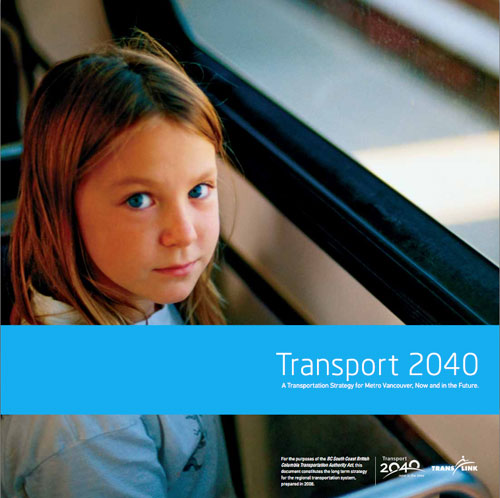




Are there any opportunities for volunteers to contribute to the achieving of the various goals? I get the impression that once the goals have been set, the most that we can do is sit back and pray.
I would like to see more volunteer opportunities, so that we can make things happen, if those things are meaningful to us. Sometimes, I feel that Translink ignores me, and I grow tired of waiting.
You know, the idea of having volunteer opportunities is a really powerful insight. I’ll pass your comments along to the Powers that Be and let them know this is something that you’re thinking about.
Sorry, but I have to say it: that girl on the cover is very, very creepy.
(PS: Are we still able to login if we want to?)
You can still log in if you want to. Use this link: http://buzzer.translink.ca/wp-login.php
Hmm, I just thought of volunteer opportunities that might interest Translink.
Maybe we could get some volunteers to tend the gardens at the SkyTrain stations. We could start it off as a really simple project, by saying, “Sign up for which plot you’d like, and do what you want with it.”. They would have to grow legal plants, ;^) but other than that, it shouldn’t be too hard to manage. Famous last words, eh? :^D
Also, maybe we could create a bus shelter program. There are a lot of bus stops that don’t get a lot of traffic, but it would mean a lot to the users, if they could set up a shelter. Perhaps we could coordinate with local high school woodwork classes to set up shelters. If this proves to be successful, then we could encourage students to create some art to decorate it. If we achieve that, then we could create some kind of self guided tour to show off the art.
Thanks for the practical ideas! I was just thinking about how an volunteer strategy might be implemented. Good to have your thoughts.
You’re welcome, and thank you for the feedback to our feedback. :^D I hate the idea of sending in suggestions when they might not get read by anybody significant.
I think that any volunteer efforts would become a touchy subject, because I assume that there are many union issues involved. Also, there would be public relations issues: people might begin to wonder why Translink won’t just cough up a few more dollars.